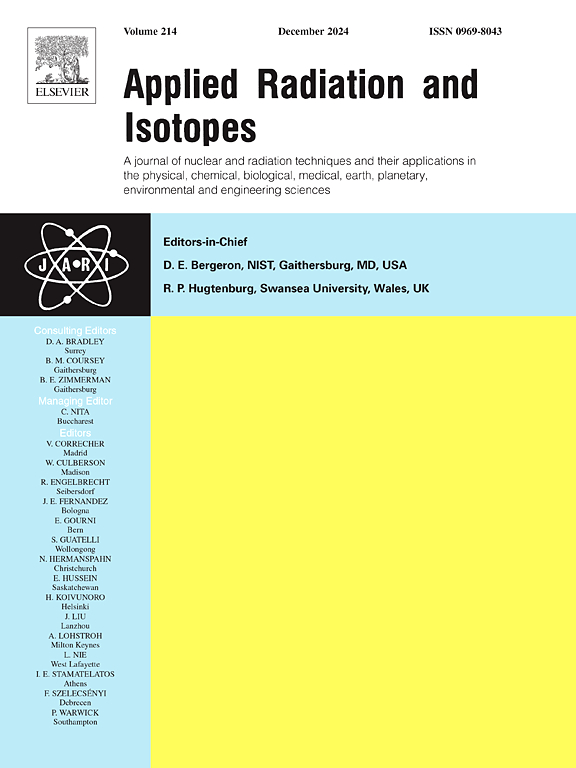伽马射线辐照东方鸦胆子精油在防治鸦胆子幼虫和成虫方面的活性。
IF 1.6
3区 工程技术
Q3 CHEMISTRY, INORGANIC & NUCLEAR
引用次数: 0
摘要
库蚊是全球西尼罗河病毒的主要传播媒介,分布广泛。为了避免害虫对传统合成杀虫剂产生抗药性,人们尝试研究植物杀虫剂。害虫对合成杀虫剂的抗药性越来越强,对生态系统的多样性构成了威胁,因此植物杀虫剂的研究显得更加重要。该研究旨在确定用 1、3 和 5 KGy 照射东方鸦雀精油与未照射东方鸦雀精油相比,东方鸦雀精油作为杀幼虫剂对琵鹭第三龄幼虫的药效,使用了六种不同的浓度(15、20、25、30、35 和 40 ppm),作为成虫杀虫剂对大约三天大的雌性成虫的药效分别为 0.2%、0.4%、0.6%、1% 和 2%。结果表明,与未经过辐照的精油(半数致死浓度为 27.28 ppm)相比,经过 5 KGy 辐照的精油在 24 小时后对三龄幼虫的半数致死浓度(20.16 ppm)最高,其次是经过 3 KGy 和 1 KGy 辐照的精油(半数致死浓度分别为 23.16 ppm 和 26.00 ppm)。在 5 至 60 分钟的不同暴露时间内,成虫的击倒效果随着油的浓度越高而显著增加。在 0、1 和 3 千克辐照度下,用最高浓度 2% 的东方桉树精油 100%杀死蚊子的时间为 20 分钟;在 5 千克辐照度下,用最高浓度 2% 的东方桉树精油 100%杀死蚊子的时间为 10 分钟。我们的研究结果表明,用伽马射线辐照东方蓟马果实可提高其精油对库蚊的功效,辐照后的精油可成功用于防治这些昆虫。用扫描电子显微镜(SEM)观察了暴露于未经过辐照或经过辐照的东方柚精油的三龄幼虫的头囊、触角和腹部末节。本文章由计算机程序翻译,如有差异,请以英文原文为准。
Larvicidal and adulticidal activity of irradiated Thuja orientalis essential oil by gamma radiation for controlling Culex pipiens
Culex pipiens mosquitoes are the primary vector of the West Nile virus worldwide and have a wide distribution. To avoid the development of resistance in insect pests to conventional synthetic pesticides, there have been many attempts to study botanical pesticides. The increasing resistance of insect pests to synthetic pesticides is a threat to the diversity of ecosystems, which makes the study of botanical pesticides all the more important. The study aimed to determine the efficacy of Thuja orientalis essential oil irradiated with 1, 3 and 5 KGy compared to unirradiated T. orientalis as larvicidal agents against the third instar larvae of C. pipiens using six different concentrations (15, 20, 25, 30, 35 and 40 ppm) and as an adulticidal agent against approximately three-day-old female adults 0.2, 0.4, 0.6, 1 and 2%. The results generally showed that the irradiated essential oil with 5 KGy had the highest efficacy by LC50 (20.16 ppm) followed by essential oil irradiated with 3 and 1 KGy (LC50, 23.16 and 26.00 ppm, respectively) compared to unirradiated ones (LC50, 27.28 ppm) after 24 h from the exposure for the third instar larvae. The knockdown effect for adults increased significantly with higher concentrations of the oil, across different exposure times ranging from 5 to 60 min. The time to knock down 100% of mosquito population to Thuja orientalis essential oils at the highest concentration 2% were 20 min at 0, 1, and 3 KGy and 10 min at 5 KGy. Our results indicate that gamma irradiation of T. orientalis fruit improves the efficacy of their essential oil against Culex pipiens and the irradiated oil could be successfully used for management of these insects. The head capsule, antenna, and the last abdominal segments of the 3rd instar larvae exposed to the essential oil of unirradiated or irradiated Thuja orientalis unripe were examined by the scanning electron microscope (SEM).
求助全文
通过发布文献求助,成功后即可免费获取论文全文。
去求助
来源期刊

Applied Radiation and Isotopes
工程技术-核科学技术
CiteScore
3.00
自引率
12.50%
发文量
406
审稿时长
13.5 months
期刊介绍:
Applied Radiation and Isotopes provides a high quality medium for the publication of substantial, original and scientific and technological papers on the development and peaceful application of nuclear, radiation and radionuclide techniques in chemistry, physics, biochemistry, biology, medicine, security, engineering and in the earth, planetary and environmental sciences, all including dosimetry. Nuclear techniques are defined in the broadest sense and both experimental and theoretical papers are welcome. They include the development and use of α- and β-particles, X-rays and γ-rays, neutrons and other nuclear particles and radiations from all sources, including radionuclides, synchrotron sources, cyclotrons and reactors and from the natural environment.
The journal aims to publish papers with significance to an international audience, containing substantial novelty and scientific impact. The Editors reserve the rights to reject, with or without external review, papers that do not meet these criteria.
Papers dealing with radiation processing, i.e., where radiation is used to bring about a biological, chemical or physical change in a material, should be directed to our sister journal Radiation Physics and Chemistry.
 求助内容:
求助内容: 应助结果提醒方式:
应助结果提醒方式:


